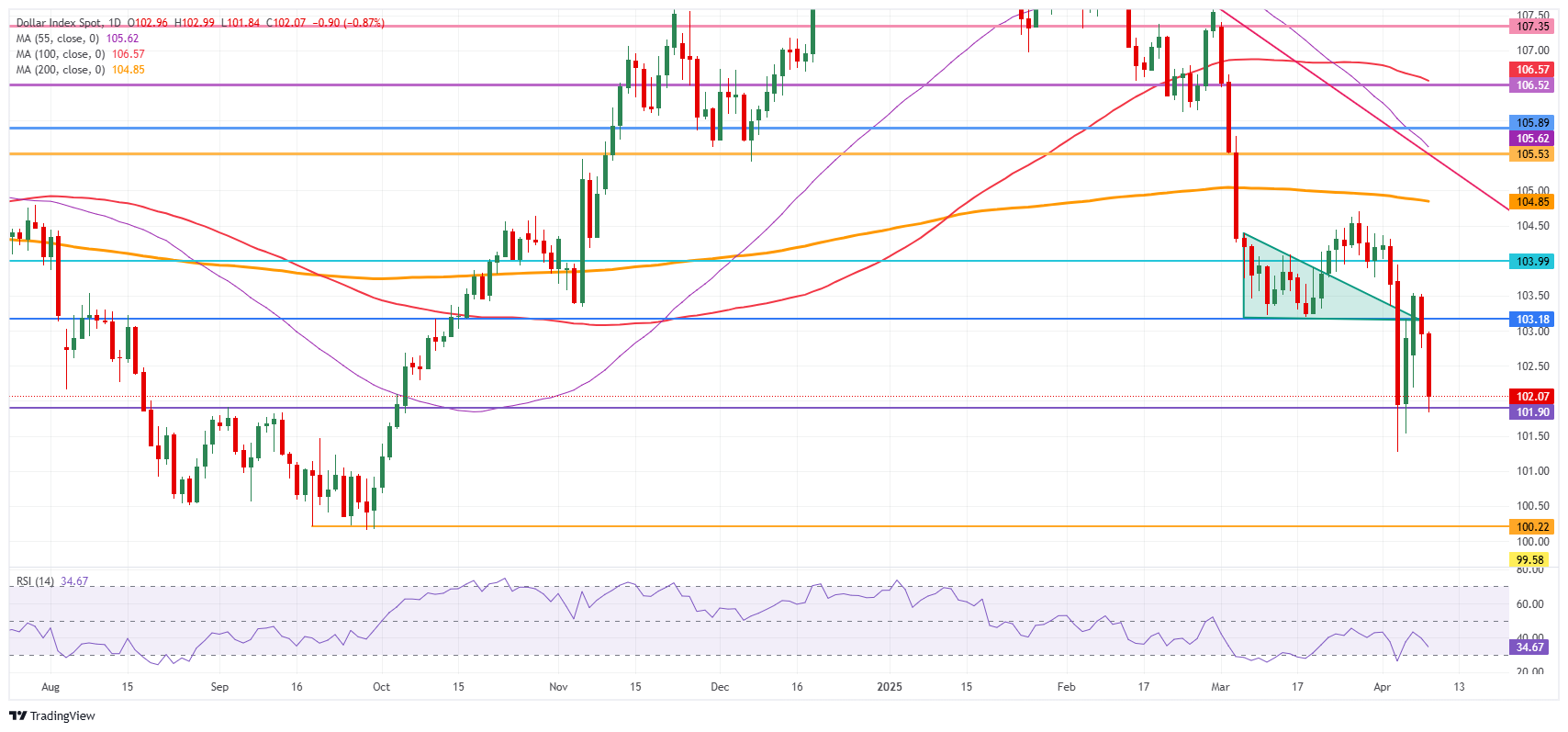-
The US dollar weakens against most major currencies as market concerns grow over the impact of American tariffs.
-
Global equities slide after China retaliates against the US, while Bessent cautions Beijing and others against forming alliances.
-
The US Dollar Index initially retreats but shows signs of recovery during the European trading session.
The US Dollar Index (DXY), which measures the value of the greenback against a basket of six major currencies, extended its previous day’s losses on Wednesday, hovering around the 102.00 level at the time of writing. The dip follows heightened market volatility triggered by China’s announcement of sweeping tariffs on US imports.
On April 10, the Chinese Ministry of Finance confirmed it will impose tariffs of up to 84% on all US goods. The move was a direct retaliation to Washington’s recent tariff decisions and has reignited fears of an intensifying trade war.
US Treasury Secretary Scott Bessent responded promptly, stating that China would ultimately be the biggest loser in a tariff war and urging Beijing to return to the negotiating table. According to Bloomberg, Bessent also warned China against manipulating its currency, stressing that devaluation would not be a viable way to offset tariff impacts.
In a more pointed remark, Bessent cautioned Europe against aligning with China, saying such a move would be akin to "cutting its own throat."
Adding to the chorus of reassurance, President Donald Trump took to his Truth Social platform to urge Americans to “be cool,” insisting that “everything is going to work out well,” Baha News reports. The combined remarks from both the Treasury Secretary and the President appear to be aimed at easing growing anxiety across the business, political, and social spheres in the US.
Markets now turn their attention to the Federal Reserve’s upcoming policy signals. While Wednesday’s economic calendar is relatively light, anticipation is building for the release of the March FOMC Minutes later in the day. However, expectations are muted as Fed Chair Jerome Powell recently indicated a “wait-and-see” approach regarding monetary policy.
Despite the Fed’s cautious tone, rate cut bets are accelerating. According to the CME FedWatch Tool, the probability of a rate cut in May has surged to 53.5%, up sharply from just 10.6% a week ago. For June, the market sees a 100% chance of a cut, with over half expecting a 50 basis-point reduction.
Market Movers: Key Highlights
-
China Tariffs: China confirms 84% tariffs on all US goods starting April 10 (Bloomberg).
-
Mortgage Data: Weekly mortgage applications jumped 20%, rebounding from a previous -1.6% reading.
-
Fed Comments: Minneapolis Fed President Neel Kashkari said both rate cuts and hikes remain on the table.
-
Wholesale Inventories: February data met expectations, posting 0.3% growth.
-
Fed Speeches: Richmond Fed President Thomas Barkin is scheduled to speak at 16:30 GMT in Washington.
-
FOMC Minutes: Scheduled for release at 18:00 GMT, with limited surprises anticipated.
- Global equity markets declined sharply following China’s retaliation, with most major indices falling by at least 2% on the day. However, US equities have shown some resilience, with the Nasdaq leading a mild rebound, up around 1%.
- The yield on the 10-year US Treasury sits at approximately 4.36%, continuing its upward trend even as expectations of rate cuts grow. This divergence highlights investor uncertainty over the Fed's next steps and the broader economic outlook.
Technical Outlook: DXY at a Crossroads
Technically, the DXY is testing critical support at 101.90, which has served as a key floor in recent weeks. While the index appears to be stabilizing for now, the broader downtrend suggests that a break below this level could open the door for a slide toward the psychologically important 100.00 mark.
On the upside, initial resistance stands at 103.18—previously a key support level in March—followed by the 104.00 level and the 200-day Simple Moving Average (SMA) at 104.85.
As geopolitical tensions escalate and economic uncertainty grows, the US dollar faces increased pressure. All eyes will be on the Federal Reserve’s communication for clues on the path ahead, with markets leaning heavily toward a more accommodative monetary policy stance later in 2025.






